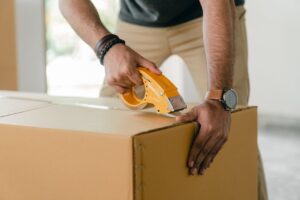Hardwood flooring is a timeless feature in any home, adding warmth and elegance to your living space. However, the process of packing and moving can pose a significant risk to these beautiful surfaces. Without proper precautions, scratches and dents can easily mar the finish, leaving your floors looking worn and damaged. Protecting your hardwood floors during a move doesn’t have to be complicated, but it does require thoughtful planning. In this guide, we’ll explore how you can protect your hardwood from scratches while packing up your home.
Understanding the Risks to Hardwood Floors
Before diving into specific solutions, it’s essential to understand the risks involved. Packing and moving often involve heavy furniture, sharp-edged boxes, and frequent foot traffic. Each of these elements can contribute to scratches, dents, or even gouges in your hardwood flooring. Knowing what to watch out for is the first step in preventing damage. It’s also helpful to identify high-risk zones in your home, such as entryways and hallways, where the flooring might endure the most wear and tear during the move.
Decluttering Before Packing Reduces Risk
One of the best ways to minimize the risk to your hardwood is to start with a clutter-free space. Decluttering not only makes packing more efficient but also reduces the chances of tripping over items and dragging them across the floor. Carefully sort through your belongings and consider donating, recycling, or disposing of anything you no longer need. This will create a cleaner, safer environment to work in and limit the likelihood of accidents. Additionally, fewer items mean less weight being moved across your floors, further reducing the potential for damage.
Choosing the Right Packing Materials
Investing in high-quality packing materials can make a significant difference in protecting your hardwood. Cardboard boxes, packing tape, and bubble wrap are essential but don’t forget about floor protection. Felt pads, furniture sliders, and non-slip floor coverings are excellent options for shielding your flooring from scratches. Place these materials strategically under heavy items and along high-traffic areas to create a protective barrier. When selecting these materials, opt for reusable options where possible to make your move more eco-friendly.

Preparing Furniture for Safe Moving
Heavy furniture is one of the biggest culprits when it comes to hardwood damage. To prevent scratches, lift furniture rather than dragging it across the floor. Use felt pads or furniture sliders under each leg to reduce friction. If possible, disassemble large items like tables or bed frames to make them easier to move. When packing appliances for the move, ensure they are clean and dry, as any residual moisture or dirt can transfer to your floors and cause damage. Wrapping furniture in blankets or moving pads provides an extra layer of protection for both the furniture and your floors.
Creating Temporary Walkways
Another effective strategy is to create temporary walkways in high-traffic areas. Use floor runners, old blankets, or even cardboard to cover pathways where movers and family members will frequently walk. These materials provide a buffer between shoes and your hardwood, reducing the chances of scuffs and scratches. For maximum effectiveness, secure these coverings with non-slip tape to prevent accidental shifting or tripping.
Keeping Floors Clean During the Packing Process
Clean floors are less prone to damage. Dirt and debris act like sandpaper underfoot, scratching the surface of your hardwood as people walk over it. Before you start packing, thoroughly sweep and mop your floors to remove any particles. Continue cleaning periodically throughout the process, especially in areas with heavy use. Keeping cleaning supplies easily accessible ensures you can address spills or debris promptly, maintaining the integrity of your hardwood.
Using Floor Protectors Under Boxes
Boxes are an inevitable part of any move, but they can be surprisingly harsh on hardwood surfaces. Always lift boxes rather than sliding them to avoid scratching the floor. Place a soft barrier, such as a blanket or towel, underneath if you need to set boxes down. This simple step can prevent sharp edges from gouging your hardwood. Additionally, consider stacking lighter boxes on heavier ones to minimize direct contact with the floor.
Planning the Order of Packing
The way you approach packing can also impact the condition of your floors. Start packing and moving items from rooms farthest from the exit to minimize the distance boxes and furniture need to travel across your hardwood. This reduces the overall risk of damage. Additionally, consider packing one room at a time to maintain a sense of order and reduce unnecessary foot traffic. Planning your packing sequence ensures smoother navigation and prevents unnecessary back-and-forth that could harm your flooring.
Wearing the Right Footwear
Footwear choices may not seem important, but they can significantly affect your hardwood flooring. Avoid wearing shoes with hard soles or heels, which can easily scratch the surface. Opt for soft-soled shoes, socks, or slippers instead. Encourage movers and helpers to do the same to further protect your floors. To make compliance easier, consider placing a small shoe rack and a supply of disposable shoe covers near the entrance.
Communicating with Movers
If you’re hiring professional movers, make sure they understand the importance of protecting your hardwood floors. Discuss your concerns with them ahead of time and ask about their floor protection practices. Many reputable moving companies will bring their own supplies, such as floor runners or protective padding, to ensure your floors remain in good condition. A proactive discussion can also help you identify areas that need extra attention, such as tight corners or narrow doorways.

Inspecting Your Hardwood Post-Move
After all the packing and moving is complete, take the time to inspect your hardwood floors. Look for any scratches, dents, or other damage that may have occurred. If you find minor scuffs, they can often be repaired with a wood floor cleaner or polish. For deeper scratches, consider consulting a professional to restore your floors to their original beauty. Documenting any damage immediately can also be helpful if you need to file a claim with your movers or insurance.
Protect Your Hardwood From Scratches Effortlessly
Protecting your hardwood floors while packing is crucial to ensuring your home remains in excellent condition during a move. Understanding the risks, using appropriate materials, and taking preventive measures can protect your hardwood from scratches and dents. Whether packing appliances for the move or simply organizing smaller items, each step you take to protect your hardwood will pay off in the long run. With careful planning and attention to detail, you can successfully move to your new home without compromising the beauty of your flooring. Remember, preserving your hardwood floors maintains their aesthetic appeal and retains the value of your home for years to come.
Photos used:
https://www.pexels.com/photo/brown-coffee-table-on-green-area-rug-279607/
https://www.pexels.com/photo/crop-man-taping-carrying-box-with-scotch-4246120/
https://www.pexels.com/photo/man-in-blue-denim-jeans-sitting-on-green-sofa-7464722/

